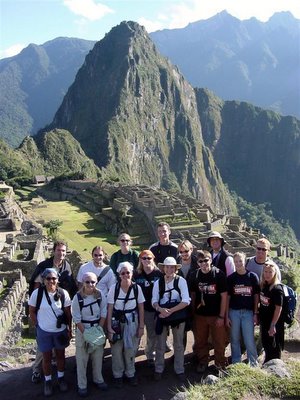
Contact: silmanmr@wfu.edu
Tropical Biodiversity is an in-depth, hands-on field course exposing students to the rich and varied ecosystems of the tropics, from absolute deserts to glaciers to tropical rain forest. It travels to the largest tropical wilderness left on the planet, and the course will take us through the spectrum of tropical ecosystems and put us in some of the wildest and most pristine areas left on the planet. In these living classrooms we will combine lectures on the history, generation, maintenance, and future of tropical biodiversity with field projects on a variety of plant and animal topics, from conservation to geology to tree diversity to primate behavior. We'll also get first hand experience in tropical conservation. In 2015 we will have addition scholars and conservation biologists on the trip as resources.
Check out the student's blog from a past course for a student's perspective.
The Places
After arriving in the capitol city in Lima, we’ll travel by bus through the world’s driest desert to Paracas National Park. Located on a peninsula in the Pacific Ocean, Paracas is a rich-upwelling zone teeming with bird and mammal life. Sea otters, sea lions, penguins, boobies, and the spectacular Inca Tern are among a few of the animals we’ll see there. The abundant marine life is juxtaposed with absolute desert, receiving less than 2mm of precipitation a year. This has led to a unique and fragile flora that lives exclusively on moisture harvested from coastal fog on the tops of the highest hills.
Leaving Paracas, the course flies over the Andes to the imperial city of the Inca Empire, Cusco. There we will travel to the Sacred Valley of the Incas and Machu Picchu, giving us a chance to see and study the unique mammal and bird fauna of the high Andes, from the relatives of camels such as llamas, vicuñas, alpacas, and the pika-like vizcacha to torrent ducks and Andean condors. We will overnight at Machu Picchu, affording students a chance to explore this magnificent ancient city in depth.
From Cusco we will travel by bus up and over the east range of the Andes, passing through remote Andean villages where the ancestors of the Inca still live much as the did 500 years ago. Passing the crest of the Andes, we enter Manu National Park—the world’s premier rain forest park—and begin our descent into the Amazon basin. We will spend a week making our way down through the different ecosystems, exploring the haunt of the rare spectacled bear and fantastic Peruvian cocks-of-the-rock. We’ll stay in the cloud forest at the Cock-of-the-Rock Lodge, giving ample time to explore this mysterious forest shrouded in clouds.
Descending further the trip will change from bus to boat—16 meter motorized dugout canoes—for our trip down the Alto Madre de Dios river and into the heart of the Manu. Along the way we will see native villages, study Andean and river geomorphology, and keep an eye-out for capybara, jaguars, and tapirs—all of which are seen frequently.
Our final destination is the Cocha Cashu Biological Station, deep in the reserved-zone of the park. Here we will execute field projects on various topics, including large-mammal ecology, primate and bird ecology, and plant ecology. Students will work in research teams on the projects and give a report at the end. This station is one of the most remote places on earth—we will be living in a veritable zoo without walls. Among our neighbors will be 13 species of monkeys, 640 species of birds including spectacular macaws and rare cracids, and a full compliment of large mammals. Cocha Cashu is one of the few places on the planet where the tropical fauna is so abundant and intact.
Travel Considerations
Health: We will be traveling to remote areas. Students are required to see a doctor and obtain vaccines for hepatitis A, yellow fever, typhoid, and antimalarial medication. Major vectors of transmission of tropical diseases such as Dengue Fever, Leishmaniasis, and Malaria are mosquitoes and biting flies, so using insect repellent with at least 20% DEET and covering exposed skin is important.
Students are also required to carry insurance valid in foreign countries, including evacuation insurance. MOST INSURANCE POLICIES DO NOT COVER YOU OUTSIDE OF THE UNITED STATES, so check with your provider. You are required to get an International Student ID, and this comes with insurance that will cover you on the trip.
This course requires vigorous activity in remote areas. Any student with a chronic medical condition or disability--physical or mental--must consult with his or her doctor and the course instructor before enrolling. We will be traveling to elevations above 15,000 feet and also conducting rigorous fieldwork in remote areas.
Cost: Most WFU students can apply for competitive scholarships and fellowships to help cover the cost of the trip. Costs include all in-Peru fees, room and board, and in-country travel. Students should bring some extra money for days spent in cities (Cusco, Lima) for the few meals not covered in the trip and for purchasing gifts, etc. A deposit is required by March 1st.
Political Stability / Safety: Peru is one of the safer South American countries. Crime in areas where we will be traveling is rare, and the political system is stable. This trip is safer than going to, say, LA or NYC.
2 comments:
Hi there, awesome site. I thought the topics you posted on were very interesting. I tried to add your RSS to my feed reader and it a few. take a look at it,
hopefully I can add you and follow...
Study Abroad
Thank you for sharing such great information. It has help me in finding out more detail about Education Loan For Study Abroad!
Post a Comment